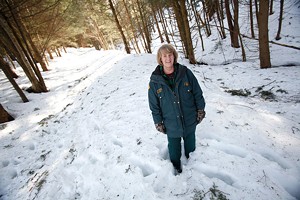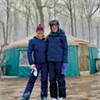Published March 23, 2011 at 9:05 a.m.
Sue Morse has made a career out of reading the language of cat urine. Not that of spoiled, little house cats that pee in the litter box, but of big, elusive predators such as Florida panthers and cougars from out west.
Morse is the founder of and science director at Keeping Track, a national nonprofit based in Huntington that trains biologists, conservation groups and any other interested individuals how to spot signs of wildlife living among them — from bobcat urine to bear-claw marks and moose tracks — for the purpose of identifying important habitats worthy of conservation.
“Animal tracking” might conjure images of simply following paw prints through the snow, but that’s not all Keeping Track does. Morse’s eight-session course instructs hundreds of clients a year how to use tracks, urine and other signs to pinpoint where wild animals are traveling, mating and eating so people can use that information to advocate for their protection to landowners and policymakers. It’s a science she describes as “deciphering stories in the snow.” Keeping Track’s revenues come from a mix of foundation grants, private philanthropy, corporate giving and fee earnings.
Raised in rural Pennsylvania, Morse came to Vermont for college in the 1960s and has since become one of the nation’s most called-upon experts in tracking and wildlife ecology. Most recently she made the media rounds to discuss the U.S. Fish and Wildlife Service’s determination that the eastern cougar, or catamount, is officially extinct. Morse’s efforts to study, collar and protect animal species have led her from the Arctic to the Everglades and put her face to face with dozens of mountain lions, bears, moose and other wildlife — encounters she’s captured in award-worthy photos.
Seven Days caught up with Morse at her light-filled post-and-beam home in Jericho, where the bookshelves overflow with field guides and ecology textbooks.
SEVEN DAYS: How did you get into tracking?
SUE MORSE: Tracking is a tool to me. I know people describe me as a tracker, but what really excites me is the relationship between animals and their habitat. So my clients quickly appreciate that they’re not simply going to learn about tracks. They’re going to learn about trees and shrubs and soils and geology and anything that pertains to the quality of habitat that animals rely upon out there. I’ve discovered that you can predict where to look for tracks and signs just by looking at animal scent marking.
SD: Animal scent marking?
SM: Each individual animal out there has its own scent signature, so no two animals are the same. If you know what kinds of materials animals like to use in scent marking, you can pinpoint where to look. It’s not just a matter of aimlessly wandering through the woods until you find the first moose tracks. Here we are in the middle of winter finding moose-reproduction sign. Or we can find evidence of bears courting one another last June.
SD: What does evidence of bear courtship look like?
SM: You would see a tree — a white birch, a red pine or a balsam fir, for example. You would see claw marks on it. If you looked closely, you’d see black bear hair stuck to wounds on the tree, from which sap exuded and hence created a medium for holding on to those hairs. And so the bear’s purpose, I believe, is to create a visual clue and also create an olfactory clue with the release of the sap, and then his or her own scent on the tree would be the message.
SD: What does wildcat urine smell like?
SM: Like cat pee. Anybody who’s ever cleaned the cat box knows that smell. Both male and female bobcats will “backward spray” throughout their habitat as part of their scent-marking behaviors.
SD: How often do people ask you about catamounts?
SM: Just about every day. But 99.9999 percent of the time, the pictures are crummy or [what they see] are dog tracks. I personally believe we don’t have a breeding, residential population of catamounts here yet. But I believe they’re on their way.
SD: When do you think they’ll arrive in Vermont?
SM: I’m guessing sometime in the next 10 or 20 years. We know there’s a breeding population in eastern Manitoba, and that really excites me, because that’s not that far away.
SD: So, do you ever just follow animal tracks?
SM: We never forward track, because I think that’s unethical. Animals have a very tight energy budget out there, and for us to recreationally confront them is wrong. It’s like waking up in your bedroom with 13 thugs in there with knives. We will back track, and back tracking reveals just as much information as forward tracking. You just don’t run the risk of confronting the animal.
SD: Have you ever been attacked by an animal you were tracking?
SM: No. But once I was followed by some very dangerous animals in the New York City subway.
SD: How healthy is Vermont’s bear population?
SM: I would say very healthy. The bear population has grown largely as a consequence of its habitat regrowing. If you were here in the ’60s, as I was, you would have seen a lot more open land and active farmland, and that wasn’t good for wildlife. That tended to be a death trap for a lot of animals.
SD: What do you think of the Pete the Moose situation [in which a Vermont landowner is claiming ownership of wildlife fenced in at his game park]?
SM: I deplore the notion that anybody would carve out a piece of habitat and own Vermont wildlife. I hope our legislators and scientists will recognize the importance of not allowing that precedent to become established.
More By This Author
Speaking of...
-

Phoenix Books to Move to Burlington's Church Street
Jun 20, 2024 -

Q&A: A Clinic Has Cared for Old North End Pets for Almost 20 Years
Jan 31, 2024 -

Video: The Old North End Veterinary Clinic Has Kept Costs Low to Help Pets in Burlington for Almost 20 Years
Jan 25, 2024 -

Q&A: Merrymac Farm Sanctuary in Charlotte Provides a Forever Home for Neglected Animals
Dec 6, 2023 -

Video: Neglected Animals Find a Home With Era MacDonald at Merrymac Farm Sanctuary in Charlotte
Nov 30, 2023 - More »
Comments
Comments are closed.
From 2014-2020, Seven Days allowed readers to comment on all stories posted on our website. While we've appreciated the suggestions and insights, right now Seven Days is prioritizing our core mission — producing high-quality, responsible local journalism — over moderating online debates between readers.
To criticize, correct or praise our reporting, please send us a letter to the editor or send us a tip. We’ll check it out and report the results.
Online comments may return when we have better tech tools for managing them. Thanks for reading.











































